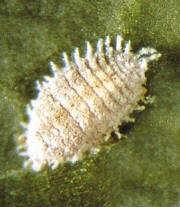 Mealy bugs (or woolly aphid) are certainly the
worst and more common insect that attack cactus and succulents,
They can live on the plant or on the roots in the soil and are
capable of very rapidly killing large specimens. Mealy bugs
belongs - like other scale insect - to the Coccoidea superfamily
and reproduce very rapidly laying their eggs underneath a
cotton-like elliptical covering so they can consequently attain
large numbers and also quickly acquire resistance to pesticides.
They are small (about 1-3mm) and have a characteristic loose,
hairy and waxy cover used to build their nests (depending on the
species) and retain well-developed legs and thus remain mobile,
even as adults, unlike most other scale insects. Mealy bugs (or woolly aphid) are certainly the
worst and more common insect that attack cactus and succulents,
They can live on the plant or on the roots in the soil and are
capable of very rapidly killing large specimens. Mealy bugs
belongs - like other scale insect - to the Coccoidea superfamily
and reproduce very rapidly laying their eggs underneath a
cotton-like elliptical covering so they can consequently attain
large numbers and also quickly acquire resistance to pesticides.
They are small (about 1-3mm) and have a characteristic loose,
hairy and waxy cover used to build their nests (depending on the
species) and retain well-developed legs and thus remain mobile,
even as adults, unlike most other scale insects.
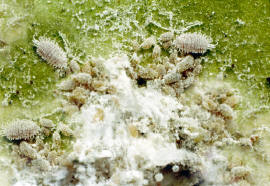
This means that
they can easily spread and infect neighbor plants!
They return over and over again. In addition many different
species are found on cacti (mostly the citrus mealy bug =
Pseudococcus (Planococcus) citri) Mealy bugs are polyphagous and are known to inject toxins into the epidermis
and spread pathogens and viruses. Plants like Asclepiads are
known to be easily infested with root mealybug and by the time
you have noticed the infestation it is too late. Root mealybug
attack the roots just below the level of the soil, especially
where the root and the stem meet.
Symptoms:
- No parts are of the plant are immune to their attack. The
infested plant appears covered with small insects,
distinguished by a grey/white cotton-wool type spot or
covering, and so difficult to see among the spines of cacti,
mostly hidden at the base of the plant at soil level, or
accumulate to feed on the tender tissues at or near the
growing point.
- Nests appear like a tuft of small waxy filaments (fluff
like).
- Plant surface are covered with sticky colourless drops,
better known as
honeydew.
- Frequently a
sooty Mould (black mould) forms on
honeydew
secretion on
the plant surfaces.
- Infested plants will stop growing, take on a sickly
appearance with distorted stem and grow point deformation and
start to shrivel.
- A crushed mealy bug leaves a characteristic red stain.
- Leaves are reduced in size, discoloured, wilted and easily
drop prematurely.
- Regular visit of ants. Ants breed and protect mealy
bugs for their honeydew secretions and may help to spread them
through the collection, so to discourage any invading ants
even though they are not harmful to the plants.
- Weakened plants often succumb to fungi and rot.
- A particular species of mealy bug attacks the roots of
cacti. This form will be seen as white patches on the roots
when repotting a plant. If a plant is unaccountably sick and
not growing, take it out of its pot and examine the roots.
Sometimes also hidden at the outer side of the pots, at the
underside of the border.
Some people manage to control and get rid of them but in
other collections they seem to last forever. In fact their waxy
and woolly covering make difficult for contact insecticides to
penetrate to the insect. They seems also able to lay dormant on
inert material for considerable periods of time breaking out
when conditions become favourable. |
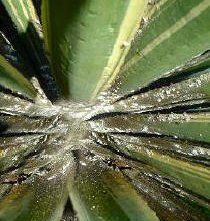
An infested plant of Agave
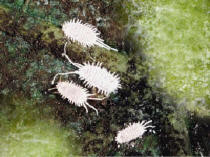
Black Sooty Mould forms on
honeydew secretion.
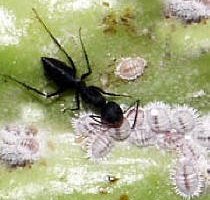
Ants "farm" mealy bugs for their
honeydew secretions
|
Cultural precautions
It is easier to keep mealy bugs out of a collection of cacti and
succulents than to control them once they are in so it is a very
good idea to quarantine new plants to see that they are not
introducing pests. As always, examine new plants before adding
them to the existing collection. Mealy bugs are visible without
any additional help. Root mealy bugs also seem to prefer
peat-based mixtures to soil-based composts, although not
exclusively.
Manual control
When infestation is not severe it is possible to patiently
picking mealy bugs off with tweezers. If there are not that many
it is possible picking them off or spraying them off with a jet
of warm water otherwise chemical control is unavoidable. Prune
or cut the parts where infestation is severe. Pruning is a job
which should be executed at sufficient distance from the
collection if possible. Watch the wind direction, eggs and first
generation nymphs can cover great distances when catched by a
breeze!
Chemical control:
Before applying insecticides/pesticides, manual removal of the
fluffy nests and most insects is advisable. It greatly increases
the chance on complete elimination of the bugs.
- Mealy Bug - It is essential that the mealy bug is
killed promptly but the cotton-wool cover can repel any
insecticide sprayed onto it, so often a wetting agent in the
insecticide spray is required. The normal way of attacking the
mealy bug is to use a contact insecticide such as malathion (not for
Crassulaceae) or systemic insecticide usually
based on a organophosphorus compound ( dimethoate is often recommended) While these can be quite effective many
strains of mealy bug have built up some resistance to these
and it may be necessary to try more than one type for
effective control! Some insecticide such as one containing Malathion can be painted on with a fine brush, kept especially
for this purpose. For large or
widespread infestations, use regular applications (weekly for
several weeks) A single application will often not be
sufficient to eliminate all the insects and their young. Before spraying be sure that plant has been well watered a day
prior to treating. This will decrease the risk of chemically
burning your cactus. Good hygiene is important as mealy bugs
love to hide under dead leaves or flowers or other places
where you and your insecticide spray cannot reach.
In a bad case, total immersion of the plant in a bucket of
insecticide will get the majority of the mealy bugs including
root mealy bugs.
- Root Mealy Bug - Remove all soil and destroy it.
Wash the roots thoroughly and treat (eventually immerging the
whole plant) with the above mentioned insecticide, letting the
roots dry after treatment and before replanting in completely
fresh, sterilized soil. Always cleanse and sterilize frames
and all other items used when replanting. Regular applications
(weekly for several weeks) of insecticide watered into the
soil are also effective, it's also possible to immerse the
plant pot up to the top of the soil in a bucket of
insecticide.
Other treatment:
- Fumigant smoke: Some fumigant smoke are
effective against mealy bugs, and have the advantage of being
a dry treatment, but require repeated use to be really
effective. Fumigation are particularly useful the
Spring and Autumn when it is too cold to spray or water the
plants with systemic insecticide.
- Moth ball: As a preventative measure, moth balls (paradichlorobenzene)
added to the potting mix seem to discourage infestation by
root mealy bug, and probably discourages other insects.
However, the chemicals in the moth balls can cause damage to
plastic plant pots and are best used with clay pots.
|